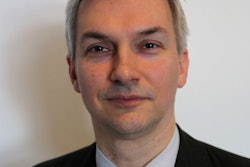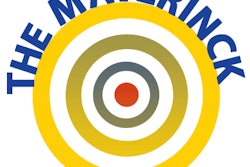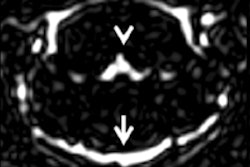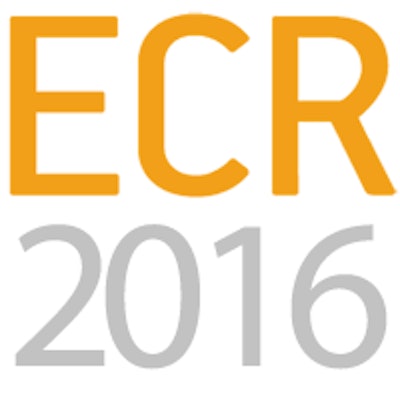
VIENNA - There's a serious risk of a phobia developing over the use of gadolinium-based MRI contrast agents, following the recent publication of a stinging attack on these agents in a German newspaper, ECR 2016 delegates were told at Friday's highly charged special focus session on brain hypersignals after repeated gadolinium administrations.
The article, headlined "Beim MRT lagert sich Metall im Gehirn ab" (When MRI metal is deposited in the brain), was published on 8 February 2016 in the Die Welt newspaper. It reported that doctors have warned that MRI examinations using contrast should be abandoned, especially in children and adolescents, unless they are absolutely necessary.
 Avoid gadolinium phobia, urges Dr. Alexander Radbruch.
Avoid gadolinium phobia, urges Dr. Alexander Radbruch.At Friday's session, Dr. Alexander Radbruch, a radiologist at Heidelberg University Hospital in Germany, expressed strong concern about the article's attempt to link gadolinium deposition with Alzheimer's disease or dementia and the suggestion that cardiovascular MRI should be replaced by myocardial scintigraphy.
"Have a guess who made this recommendation -- it was obviously a nuclear medicine guy!" said Radbruch, who received the Coolidge Award in 2013 from GE Healthcare for his work on the use of new imaging techniques in brain cancer diagnostics. "There is absolutely no evidence at all of this. Radiologists really should try to avoid gadolinium phobia that would lead to an unreasonable decline of gadolinium-based contrast agents [GBCAs]."
It's vital to fully inform the public and patients that no clinical correlates are proved and no case of a visible signal intensity increase after serial applications of macrocyclic GBCAs has been documented, he continued. Also, it's important to differentiate between macrocyclic and linear GBCAs.
Radbruch urged radiologists to include the gadolinium deposition risk in the risk-benefit evaluation prior to a contrast injection. Adhering to a strict clinical indication for GBCAs, including the applied dose, is essential, and if there are no diagnostic or side effect advantages of a linear GBCA that outweigh the gadolinium deposition risk, then use macrocyclic GBCAs, he recommended.
The key question is how much gadolinium each agent deposits and in what form. More studies in this area would be helpful, he conceded.
Lessons from NSF
It's important to learn the lessons of what happened a decade ago with nephrogenic systemic fibrosis (NSF), cautioned Dr. Johannes Heverhagen, professor and head of radiology at Inselspital, University Hospital of Bern, Switzerland, during the panel discussion. It was found that some gadolinium-based contrast agents may trigger the development of NSF, a generalized fibrotic disorder, in renal failure patients. Multiple factors might be at work here, he noted.
 From a clinical viewpoint, open questions remain, says Dr. Tarek Yousry.
From a clinical viewpoint, open questions remain, says Dr. Tarek Yousry.One lesson we should have learned is that in NSF everybody initially thought that the most important factor was the configuration of the agent (linear versus macrocyclic), but in the meantime we found that dose is the crucial issue, he explained. As soon as we restricted dose, almost no cases of NSF were detected. The only cases that developed after the precautions issued by the European Medicines Agency and Food and Drug Administration can be attributed to overdosing, Heverhagen added.
He said he was worried that the studies reportedly proving the safety of these agents in the brain were relatively small, single-center, and retrospective. Also, every agent deposits gadolinium in the brain, and it's quite possible the regulatory authorities will insist on all of these agents being removed from the market, and then radiologists will be in real trouble, he added. More data and well-defined clinical studies are needed so that firm conclusions can be drawn.
"Be careful about personal bias, selection bias, and information bias in all these small single-center studies," said Dr. Alberto Spinazzi, senior vice president and head of global medical and regulatory affairs at Bracco Group in Milan. "It's an easy way out to say that linear agents are the bad guys."
Spinazzi and others are currently helping the European Medicines Agency undertake a review in this area, but no new guidelines or reports are expected imminently.
At University College London (UCL) in the U.K., neurologists started asking last summer what they should do about the concerns surfacing over gadolinium contrast, explained Dr. Tarek Yousry, professor of neuroradiology at the UCL Institute of Neurology.
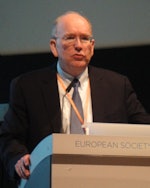 Overall, gadolinium chelates have an excellent safety profile, notes Dr. Val Runge.
Overall, gadolinium chelates have an excellent safety profile, notes Dr. Val Runge."I told them we should do nothing. There's no proof this is harmful. We need to be careful with contraindications, but that's our job and we're always careful," he said. "Having to make a decision now, I don't see why I should not go for macrocyclic. For me, that's the only way forward at this point in time."
From a clinical perspective, several unanswered questions remain, but as the U.S. Food and Drug Administration made clear in a statement issued in July 2015, no consequences of gadolinium deposition for patient health and no adverse health effects have been identified, Yousry pointed out.
Industry is doing tremendously important background research in this area, but the precise effects of gadolinium deposits in the brain are still unclear, added session moderator Dr. Val Runge, professor of radiology at the University Hospital of Bern in Switzerland and editor in chief of Investigative Radiology.
"It's very important to note that gadolinium chelates are critical to medicine today and are critical to radiology, and overall have a very good safety profile -- in fact, an excellent safety profile," he said.
Further information is available on this topic at rinckside.org.




